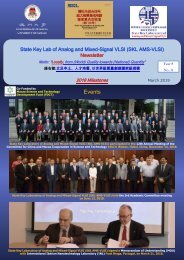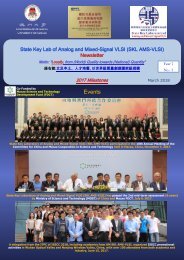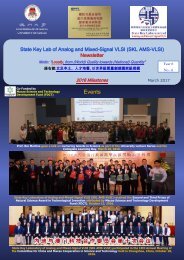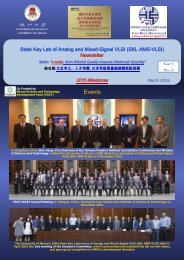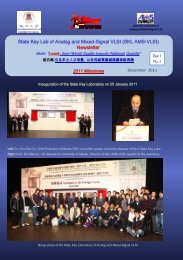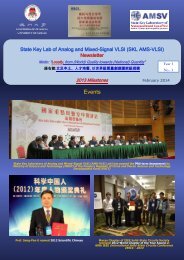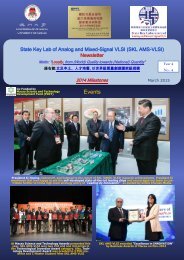IME Newsletter 2019
IME Newsletter 2019
IME Newsletter 2019
Create successful ePaper yourself
Turn your PDF publications into a flip-book with our unique Google optimized e-Paper software.
State Key Lab of Analog and Mixed-Signal VLSI (SKL AMS-VLSI)
Newsletter
Motto: “Locally, from (World) Quality towards (National) Quantity”
座 右 銘 : 立 足 本 土 、 人 才 培 養 , 以 世 界 級 質 量 創 建 國 家 級 規 模
Year 9
No . 9
2019 Milestones
March 2020
Co-Funded by
Macao Science and Technology
Development Fund (FDCT)
Events
State Key Laboratory of Analog and Mixed-Signal VLSI (SKL AMS-VLSI) co-organised the 1st Workshop on IC Advances in
China (ICAC Workshop) held in Chengdu, Sichuan, China, April 10-12, 2019.
State Key Laboratory of Analog and Mixed-Signal VLSI (SKL AMS-VLSI) jointly held the “Advanced IC Summer Course” for
people from the Greater Bay Area (GBA) and beyond during 2019 summer.
Institute of Microelectronics (IME) held a three-day
Integrated Circuit (IC) Experience Summer Camp for
Macao secondary school students during 2019 summer.
Prof. U Seng Pan and Prof. Mak Pui In received
Commemorative Medals for PRC’s 70th anniversary.
State-of-the-Art Chips - Designed and Tested in 2019 (29 chips)
ISSCC 2020
A team of faculty members and students from the SKL AMS-VLSI and ECE/FST, University of Macau (UM) published their results
to the 66th IEEE International Solid-State Circuits Conference (ISSCC) in February 2020 in San Francisco, CA, USA, the
most competitive conference in the world in the field of chip design. However, due to the Outbreak of the New Corona Virus
followed by the Declaration of Public Health Emergency of International Concern by World Health Organization, the SKL AMS-
VLSI delegation was reluctantly absent from this significant event in the area this year.
This year, 6 papers/chips in areas of Data Converters, RF and Power Management were accepted at ISSCC 2020, with the following title,“A
2.56mW 40MHz-Bandwidth 75dB-SNDR Partial-Interleaving SAR-Assisted NS Pipeline ADC With Background Inter-Stage Offset Calibration”,
“A 1.4-to-2.7GHz FDD SAW-Less Transmitter for 5G-NR Using a BW-Extended N-Path Filter-Modulator, an Isolated-BB Input and a Wideband
TIA-Based PA Driver Achieving <-157.5dBc/Hz OB Noise”, “A 2-Phase Soft-Charging Hybrid Boost Converter with Doubled-Switching Pulse
Width and Shared Bootstrap Capacitor Achieving 93.5% Efficiency at a Conversion Ratio of 4.5”, “A 4× Interleaved 10GS/s 8b Time-Domain
ADC with 16× Interpolation-Based Inter-Stage Gain Achieving >37.5dB SNDR at 18GHz Input”, “A Single-Channel 5.5mW 3.3GS/s 6b Fully
Dynamic Pipelined ADC with Post-Amplification Residue Generation”, “A 9mW 54.9-to-63.5GHz Current-Reuse LO Generator with a 186.7dBc/
Hz FoM by Unifying a 20GHz 3 rd -Harmonic-Rich Current-Output VCO, a Harmonic-Current Filter and a 60GHz TIA”. Besides, the SKLab PhD
students received 1 Student Research Preview and Prof. Prof. Man-Kay Law originally planned to deliver a tutorial on “Capacitive Sensor Interfaces”.
SKL AMS-VLSI team Stepped Up
Development of Coronavirus Detection
System to Tackle Epidemic Outbreak
SKL AMS-VLSI and Harvard’s Collaboration
Slashed Cost and Time of NMR Tests with
Electronic Chips
UM Researchers in Biology/Electronics
Diagnosis Develop New Cancer Drug
Screening Method
In order to speed up the detection of novel coronavirus,
AMSV has stepped up the development of
a digital-microfluidic-chip-based system to help
tackle the epidemic outbreak. With the help of
‘Virus Hunter’, a rapid test kit developed with UM
patented technology, the whole virus detection
process can be completed within 30 minutes. The
study was conducted by a team formed by researchers
from UM’s State Key Laboratory of Analog
and Mixed-Signal VLSI (AMS-VLSI) and PhD
graduates. The research team has been in touch
with relevant medical units and the system will be
available to frontline medical personnel upon
verification.
The State Key Laboratory of Analog and Mixed-
Signal VLSI (SKL AMS-VLSI) and Harvard University
have developed a portable nuclear magnetic resonance
(NMR) platform by using advanced integrated
circuits technology. The platform not only can
significantly improve the efficiency and effectiveness
of NMR tests; it can also be applied in biological
diagnostic tests. For instance, conducting blood
and protein tests with this platform is much cheaper
and faster than using the traditional NMR testing
method.
An interdisciplinary research team from the
University of Macau (UM) developed a new
screening method for cancer drugs. Using a
digital microfluidic system, the research team can
run single cell drug screening tests with a limited
number of biopsy samples. As an efficient and
precise method, the screening process for a
cancer patient can be completed within 24 hours,
which can help provide timely guidance for doctors
on medication prescription. The research
results have been published by the authoritative
international journal Microsystems & Nanoengineering
under Nature Publishing Group.
6 New PhD Graduates
6. Xiaofeng Yang, Inductor-less Low Jitter Clock Circuit Techniques
and Design Considerations, 2019
Prof. Jia Yanwei received awards
at International Multidisciplinary
Conference on Optofluidics
A Book by Springer
A Joint-Chapter in a
Book by Elsevier
5. Wei Wang, Design of Low-Power Mega to Hundred Mega Hz
Bandwidth CTDSM, 2019
4. Liang Qi, Low-Power Cascaded Delta-Sigma Modulator for Wideband
Telecommunication Applications, 2019
3. Biao Wang, Resolution Enhancement Techniques for Multi-Bit
Incremental ADC, 2019
2. Shiheng Yang, Power-Efficient Analog and Digital Frequency Synthesizers
in Nanoscale CMOS, 2019
1. Haidong Yi, Ultra-Low-Voltage Analog and RF Circuit Techniques
for Short-Range Wireless Radios in Nanoscale CMOS, 2019
Selected works from each research line
In ISSCC 2019 and JSSC 2020
27.3 A Piezoelectric Energy-Harvesting Interface Using Split-Phase
Flipping-Capacitor Rectifier and Capacitor Reuse Multiple-VCR SC
DC-DC Achieving 9.3× Energy-Extraction Improvement
Zhiyuan Chen, Yang Jiang, Man-Kay Law, Pui-In Mak, Xiaoyang Zeng, and Rui P. Martins
From Wireless research line
Motivation
Architecture
Piezoelectric energy harvesters (PEH) exhibit promising features
to scavenge the ambient vibration energy for ubiquitous miniaturized
Internet of Things (IoT) devices. For the traditional PEH using
the full-bridge rectifier (FBR), the PEH inherent capacitance (C p )
limits the extractable AC-DC electrical power. Even though PEH
interfaces employing non-linear techniques such as the parallelsynchronized-switch
harvesting-on-inductor (P-SSHI) can increase
the harvestable energy by extending the damping duration, they
typically require bulky external high-Q inductors to enhance the
extracted power. Recently, various inductor-less PEH interfaces
exploiting only capacitors for flipping the PEH voltage during the
zero-crossing of the PEH current (I p ) have been reported. However,
their achievable energy extraction improvement highly depends
on the number of flipping phases. This work proposes a splitphase
flipping-capacitor rectifier (SPFCR) implementation entailing
only 4 capacitors, while achieving the highest number of phases
(21) when compared with the recent art. To resolve the lack of
input power (P in ) adaptability, this work proposes a capacitorreuse
multiple voltage conversion ratio (VCR) switched-capacitor
(SC) DC-DC converter to reduce the charge redistribution loss.
Maximum power point tracking (MPPT) is also accomplished using
the fractional FBR open circuit voltage (V OC,FBR ) for relaxed voltage
tolerance, while raising the PEH extracted energy. This work
demonstrates a measured 9.3x energy-extraction improvement
when compared with the conventional FBR interface.
Result I
Result II
Verification:
Performance Comparisons:
A Millimeter-Wave Multi-Resonant-RLCM-Tank VCO Exploiting
a Single-Turn Multi-Tap Inductor and CM-Only Switched-Capacitor
Arrays
From Wireless research line
Hao Guo, Yong Chen, Pui-In Mak, and Rui P. Martins
In ISSCC 2019 and JSSC 2020
Motivation
This paper reports an area-efficient millimeter-wave
VCO featuring a multi-resonant Resistor-Inductor-
Capacitor-Mutual inductance (RLCM) tank to improve
the phase-noise performance at low power.
Specifically, we incorporate a single-turn multi-tap
inductor with common-mode (CM)-only switchedcapacitor
arrays to generate and align the 1 st , 2 nd and
3 rd harmonic resonances; all with high intrinsic quality
factor and impedance. Prototyped in 65-nm CMOS
technology, the VCO achieves a FOM @1MHz up to
191.6 dBc/Hz over a 16% tuning range (25.5 to 29.9
GHz), while exhibiting a low 1/f 3 phase noise corner
between 130 to 230 kHz. The die area is 0.08 mm 2 .
Architecture
Implementation
Verification
A 2.56mW 40MHz-Bandwidth 75dB-SNDR Partial-Interleaving
SAR-Assisted NS Pipeline ADC With Background Inter-Stage
Offset Calibration
Yan Song, Yan Zhu, Chi Hang Chan, Rui P. Martins
From Data Conversion and Signal Processing research line
In ISSCC 2020
Motivation
Architecture
Implementation
Verification
In ISSCC 2019 and JSSC 2020
A 76.6dB-SNDR 50MHz-BW 29.2mW Noise-Coupling-Assisted CT
Sturdy MASH ΔΣ Modulator with 1.5b/4b Quantizers in 28nm CMOS
Liang Qi, Ankesh Jain, Dongyang Jiang, Sai-Weng Sin, Rui P. Martins, Maurits Ortmanns
From Data Conversion and Signal Processing research line
Motivation
Architecture
This work presents a dual-loop noise-couplingassisted
continuous time (CT) sturdy multi-stage
noise shaping (SMASH) ΔΣ modulator (DSM), employing
1.5bit/4bit quantizers, respectively. The proposed
SMASH can equivalently work as an overall
fourth-order DSM with 4bit internal quantization. The
noise coupling applied in this CT SMASH DSM whitens
the 1.5bit quantization noise and further reduces
its in-band tone power, while a finite impulse response
filter integrated into the outermost feedback
path suppresses the out-of-band noise power of the
multibit DAC input. Together, they avoid any linearization
technique for the multibit DAC. Sampled at
1.2GHz, the 28nm CMOS experimental prototype
measures an SNDR of 76.6dB and an SFDR of
87.9dB over a 50MHz bandwidth, consuming
29.2mW from 1.2V/1.5V supplies and occupying an
active area of 0.085mm2. It exhibits a Schreier figureof-merit
(SNDR) of 168.9dB.
Block diagram of the proposed CT dual-loop Sturdy MASH.
Circuit Implementation
Implementation
Verification
Low-Latency Single Channel Real-Time Neural Spike Sorting
System Based on Template Matching
Pan Ke Wang, Sio Hang Pun, Chang Hao Chen, Elizabeth A. McCullagh,
Achim Klug, Anan Li, Mang I. Vai, Peng Un Mak, Tim C. Lei
From Biomedical research line
In PLOS ONE 2019
Motivation
Architecture
In this work, a rapid spike sorting system was developed based on
template matching to rapidly calculate instantaneous firing rates
for each neuron in a multi-unit extracellular recording setting. Cluster
templates were first generated by a desktop computer using a
non-parameter spike sorting algorithm (Super-paramagnetic clustering)
and then transferred to a field-programmable gate array
digital circuit for rapid sorting through template matching. Two
different matching techniques–Euclidean distance (ED) and correlational
matching (CM)–were compared for the accuracy of sorting
and the performance of calculating firing rates.
The performance of the system was first verified using publicly
available artificial data and was further confirmed with prerecorded
neural spikes from an anesthetized Mongolian gerbil.
Real-time recording and sorting from an awake mouse were also
conducted to confirm the system performance in a typical behavioral
neuroscience experimental setting. Experimental results indicated
that high sorting accuracies were achieved for both template
-matching methods, but CM can better handle spikes with non-
Gaussian spike distributions, making it more robust for in vivo
recording. The technique was also compared to several other offline
spike sorting algorithms and the results indicated that the
sorting accuracy is comparable but sorting time is significantly
shorter than these other techniques. A low sorting latency of under
2 ms and a maximum spike sorting rate of 941 spikes/second have
been achieved with our hybrid hardware/software system. The low
sorting latency and fast sorting rate allow future system developments
of neural circuit modulation through analyzing neural activities
in real-time.
Verification I
Verification II
An Analog-Proportional Digital-Integral Multiloop Digital LDO With
PSR Improvement and LCO Reduction
Mo Huang, Yan Lu, and Rui P. Martins
In CICC 2019 and JSSC 2020
From Integrated Power research line
Motivation
In granular power management for SoCs, a
low central supply is generated by a
switching converter first, and then distributed
to fine-grained voltage domains using
low-dropout regulators (LDOs). For a high
power efficiency, a small dropout voltage of
LDO is needed. Moreover, power supply
rejection (PSR) to the ripple up to several
MHz is required. Good PSR can be
achieved by analog LDO only under a high
supply voltage. By contrast, digital LDO is
suitable for low supply voltage, but suffers
from poor PSR, slow transient response
and steady-state limit cycle oscillation
(LCO). This work incorporates both
schemes and proposes a hybrid LDO with
analog-P and digital-I controls for a fast response,
improved PSR and reduced LCO
at a low supply voltage.
Architecture
Five-loop hybrid LDO is implemented.
Loop-1 is the main analog-P path for fast
response. Loop-2 is useful for light load
regulation and PSR. Loop-3 is the replica
loop of Loop-1 and -2 to bias Loop-1 and
offer 6dB PSR improvement. Loop-4 and -5
are digital-I paths for coarse and fine tuning,
respectively.
Implementation
Verification
The proposed hybrid LDO was fabricated
in a 65nm CMOS process.
(a)
(b)
Measured transient response with the load current
changing from 0 to 10mA within an edge time of
5ns. A maximum 65mV output variation is observed,
and no LCO at the steady state.
A −22dB measured power supply rejection (PSR)
under a 65mV, 1MHz input voltage ripple.
In Sensors and Actuators B: Chemical 2019
Hydrodynamic-Flow-Enhanced Rapid Mixer for Isothermal DNA
Hybridization Kinetics Analysis on Digital Microfluidics Platform
Mingzhong Li, Cheng Dong, Man-Kay Law, Yanwei Jia, Pui-In Mak and Rui P. Martins
From Multidisciplinary Research Area (Microfluidics)
Motivation
Architecture
DNA hybridization kinetics has been playing a critical role in molecular
diagnostics for binding discrimination, but its study on digital
microfluidic (DMF) systems is ultimately restrained by the laminar
flow condition. The kinetic mixing technique is widely employed to
ensure a fast reaction rate, but poses intrinsic risk in cross contamination
and exhibits instable fluorescence intensity during the droplet
transportation. While the electrothermal technique can provide
stationary droplet mixing through the established thermal gradient
within the hybridization solution, the significant increase in the
droplet temperature will inevitably undermine the hybridization
equilibrium and jeopardize the binding discrimination. To enhance
the hybridization efficiency while ensuring a stable droplet temperature
(within ±0.1°C), this paper presents a DMF platform that can
perform isothermal hydrodynamic-flow-enhanced droplet mixing.
Specifically, with a single electrode, droplet-boundary oscillation
under a slow AC actuation is studied for improving the reaction
rate. The dependencies between the mixing efficiency and the
actuation voltage, actuation frequency and the spacer thickness
are also systematically studied. Reliable mixing efficiency improvement
is further validated over a wide range of solute concentrations.
The results from real-time on-chip DNA hybridization kinetics
with stationary droplets using the complete sandwiched DMF system
shows that the proposed rapid mixer can achieve the same
hybridization equilibrium with >13 times faster reaction rate when
compared to the reference one through pure diffusion, while preventing
biased hybridization kinetics as demonstrated in the electrothermal
technique.
Implementation
Verification
Technology Transfer Office and Commercialization Activities
China has been the largest consuming country for more than ten years. However, large increases in IC production and design within China have not
immediately followed. For the purpose of deeper understanding of the interdependencies between design and production, a lot of research cooperation
projects have been introduced to professors and students by Technology Transfer Office(TTO). Most of the projects are sponsored from industry. The
cooperation partners are not only from Greater Bay area, but also from other China developed cities, such as Shanghai, Beijing, etc. With the high level
R&D capability of SKL-ASMV, more than ten new cooperation projects will be on schedule in 2020.
A delegation from Hisilicon visited SKL AMSV to discuss
Number of industry-Academic Project has rapidly grown in past
three years
Increase Guangdong-Hong Kong-Macau Greater Bay Area’s Competitiveness
Macao, where land resources are limited, have greatly expanded the development space through different dimensions. One effective way is to extend
cooperation and accelerate integration with the cities in Guangdong. As one of the most promising R&D design center, SKL-AMSV has organized and
participated in many kinds of international forums in 2019. With good communication and organization, SKL-AMSV try to establish the bridge between
academia and industry. In order to provide better service and creative environment, IME has been established in Zhuhai UM Science and Technology
Research Institute as a branch. United Lab will be jointly built by university and companies in the coming year, which will continue to focus on research
and innovation of new IC products.
The establishment of Guangdong-Hong Kong-Macau
Semiconductor Industry Alliance, with delegations from
Hong Kong, Macau, Shenzhen, Guangzhou and Zhuhai.
Seminar on Macau-Hengqin Industry-University Research
Cooperation, with delegations from UM and Industry
US and International Patents Granted in 2019
1. “Palm-size μ NMR relaxometer using a digital microfluidic (DMF) device and a semiconductor transceiver for chemical/biological diagnosis,” US
Patent, US10436726B2, Oct. 2019.
2. “Reconfigurable bidirectional wireless charging transceiver,” US Patent, US10256661B1, Apr. 2019.
Upholding Scientific Leadership in ISSCC Benchmark in Terms of State-of-The-Art Chips
Academy in China 2011 2012 2013 2014 2015 2016 2017 2018 2019 2020 Total
University of Macau 2 1 1 3 2 3 6 7 8 6 39
HKUST 1 1 2 3 4 3 4 2 1 1 22
Fudan Univ. 1 1 2 1 0 0 0 2 3 1 11
Tsinghua Univ. 1 0 0 2 0 1 0 0 2 5 11
Chengdu UESTC 0 0 0 0 0 0 0 1 0 3 4
Chinese Acad. Sci. 1 0 1 1 0 0 0 0 0 0 3
Peking Univ. 0 0 0 0 0 0 0 1 0 1 2
SJTU 0 0 0 0 0 0 0 0 1 1 2
Southeast U. 0 0 0 0 0 0 0 0 1 1 2
Tianjin University 0 0 0 0 0 0 0 0 0 1 1
Xi’an Jiaotong U. 0 0 0 0 0 0 0 0 0 1 1
Awards and Student Research Previews (PhD)
in 2011 - 2020:
1 x Far-East Best Paper Award (First in China)
7 x SSCS Pre-Doctoral Achievement Awards
2 x ISSCC Silkroad Awards
1 x ISSCC Student Research Preview Award
14 x ISSCC Student Research Preview
New Academics Joined SKL AMS-VLSI in 2019
Assistant Professor
Mo Huang received the B. Sc., M. Sc., and Ph.D. degrees in microelectronics and solid-state electronics from Sun Yat-sen University, Guangzhou, China,
in 2005, 2008, and 2014, respectively. He is currently an Assistant Professor at SKL AMS-VLSI.
Research Interests: Power management integrated circuits, Energy harvesting, Wireless power transfer.
Assistant Professor
Ka-Meng Lei received the B.Sc. degrees in electrical and electronics engineering and Ph.D. degree in electrical and computer engineering from the
University of Macau (UM), Macao, China, in 2012 and 2016, respectively. He is currently an Assistant Professor at SKL AMS-VLSI.
Research Interests: Ultra-low-voltage analog IC design, Miniaturized nuclear magnetic resonance system, Sensors and analog front-end interfaces.
Events and Visits
Visit by a Delegation of China Ministry of Science and
Technology (MOST)
Visit by a Delegation of China National Development
and Reform Commission (NDRC)
Visit by a Delegation of China Academy of
Science (CAS)
Visit by a Delegation of State-owned Assets Supervision and
Administration Commission of the State Council (SASAC)
Distinguished Lectures and Workshops
“Biology and Reliable Detection of Human and
Animal Parasitic Protozoan” by
Dr. LUN Zhao-Rong,
Professor, Sun Yat-Sen University
“Nitrided and Fluorinated Graphene for the Applications
on High Mobility Graphene Transistor,
Memory and Chemical Sensors” by
Prof. Chao-Sung LAI,
Professor, Dean of Engineering College of
Chang Gung University
“Challenges and Designs of Domain-specific
Processors; Introduction of School of Microelectronics
Science and Technology of Sun
Yat-sen University” by
Prof. YU Zhiyi,
Professor, Sun Yat-sen University
SKL-AMSV-IME Sports Day
Commemorative Block Stamp with SKLab Chips’ Features for 20th
Anniversary of The Reunification of Macao with The Motherland
▓ “Adaptive Hybrid Active Power Filters, Series of Power Systems,” Springer, 2019.
▓ “Pathways to a Smarter Power System,” Elsevier Academic Press, 2019.
Book
Book Chapter
▓
SCI Journals – 40 Papers
▓ “A 40-Gb/s PAM-4 Transmitter Using a 0.16-pJ/bit SST-CML-Hybrid (SCH) Output Driver and a Hybrid-Path 3-Tap FFE Scheme in 28-nm CMOS,” IEEE Transactions on Circuits and Systems I:
Regular Papers, Dec. 2019.
▓ “A 0.6-V 13-bit 20-MS/s Two-Step TDC-Assisted SAR ADC With PVT Tracking and Speed-Enhanced Techniques,” IEEE Journal of Solid-State Circuits , Dec. 2019.
▓ “CMOS Cross-Coupled Differential-Drive Rectifier in Subthreshold Operation for Ambient RF Energy Harvesting — Model and Analysis,” IEEE Transactions on Circuits and Systems II: Express
Briefs, Dec. 2019.
▓ “Brain Rhythm Sequencing Using EEG Signals: A Case Study on Seizure Detection,” IEEE Access , Nov. 2019.
▓ “Algebraic Series-Parallel-Based Switched-Capacitor DC–DC Boost Converter With Wide Input Voltage Range and Enhanced Power Density,” IEEE Journal of Solid-State Circuits , Nov. 2019.
▓ “A -12.3 dBm Passive Sense Tag for Grid Thermal Monitoring,” IEEE Transactions on Industrial Electronics, Nov. 2019.
▓ “An Integrated DC-DC Converter with Segmented Frequency Modulation and Multiphase Co-Work Control for Fast Transient Recovery,” IEEE Journal of Solid-State Circuits , Oct. 2019.
▓ “A 0.0071-mm² 10.8ps pp-Jitter 4 to 10-Gb/s 5-Tap Current-Mode Transmitter Using a Hybrid Delay Line for Sub-1-UI Fractional De-Emphasis,” IEEE Transactions on Circuits and Systems I: Regular
Papers, Oct. 2019.
“Analysis and Verification of Jitter in Bang-Bang Clock and Data Recovery Circuit With a Second-Order Loop Filter,” IEEE Transactions on Very Large Scale Integration (VLSI) Systems, Oct.
2019.
▓ “Instantaneous Power Quality Indices Detection Under Frequency Deviated Environment,” IET Science, Measurement & Technology, Oct. 2019.
▓ “Background Offset Calibration for Comparator Based on Temperature Drift Profile,” IEEE Transactions on Circuits and Systems II: Express Briefs, Oct. 2019.
▓ “Design of KY Converter with Constant On-Time Control Under DCM Operation,” IEEE Transactions on Circuits and Systems II: Express Briefs, Oct. 2019.
▓ “Fully Integrated High Voltage Pulse Driver Using Switched-Capacitor Voltage Multiplier and Synchronous Charge Compensation in 65-nm CMOS,” IEEE Transactions on Circuits and Systems II:
Express Briefs, Oct. 2019.
▓ “Data-driven Distributed Optical Vibration Sensors: A Review,” IEEE Sensors Journal, Sep. 2019.
▓ “Continuous Artificial Synthesis of Glucose Precursor Using Enzyme-Immobilized Microfluidic Reactors,” Nature Communications, Sep. 2019.
▓ “Microfluiidc Immobilized Enzyme Reactors for Continuous Biocatalysis,” Reaction Chemistry and Engineering, Sep. 2019.
▓ “A Reconfigurable Cross-Connected Wireless- Power Transceiver for Bidirectional Device-to-Device Wireless Charging,” IEEE Journal of Solid-State Circuits, Sep. 2019.
▓ “A 4-b 7-µW Phase Domain ADC With Time Domain Reference Generation for Low-Power FSK/PSK Demodulation,” IEEE Transactions on Circuits and Systems I: Regular Papers, Sep. 2019.
▓ “A 0.0018-mm 2 153% Locking-Range CML-Based Divider-by-2 with Tunable Self-Resonant Frequency Using an Auxiliary Negative-gm Cell,” IEEE Transactions on Circuits and Systems I: Regular
▓
Papers, Sep. 2019.
“A 0.12-mm 2 1.2-to-2.4-mW 1.3-to-2.65-GHz Fractional-N Bang-Bang Digital PLL with 8-μs Settling Time for Multi-ISM-Band ULP Radios,” IEEE Transactions on Circuits and Systems I: Regular
Papers, Sep. 2019.
▓ “Suppression of Coffee-ring Effect via Periodic Oscillation of Substrate for Ultra-sensitive Enrichment towards Surface-enhanced Raman Scattering,” Nanoscale, Aug. 2019.
▓ “Cell-Based Drug Screening on Microfluidics,” Trends in Analytical Chemistry, Elsevier, Aug. 2019.
▓ “A Reconfigurable Bidirectional Wireless Power Transceiver for Battery-to-Battery Wireless Charging,” IEEE Transactions on Power Electronics, Aug. 2019.
▓ “Computationally Inexpensive Enhanced Growing Neural Gas Algorithm for Real-Time Adaptive Neural Spike Clustering,” Journal of Neural Engineering, Jul. 2019.
▓ “A 0.2-V Energy-Harvesting BLE Transmitter With a Micropower Manager Achieving 25% System Efficiency at 0-dBm Output and 5.2-nW Sleep Power in 28-nm CMOS,” IEEE Journal of Solid-State
Circuits, May 2019.
▓ “A Coin-Battery-Powered LDO-Free 2.4-GHz Bluetooth Low Energy/ZigBee Receiver Consuming 2mA,” Integration, the VLSI Journal, Elsevier, May 2019.
▓ “A 6.5x7 µm 2 0.98-to-1.5 mW NonSelf-Oscillation-Mode Frequency Divider-by-2 Achieving a Single-Band Untuned Locking Range of 166.6% (4–44 GHz),” IEEE Solid-State Circuits Letters, May
2019.
▓ “Hydrodynamic-Flow-Enhanced Rapid Mixer for Isothermal DNA Hybridization Kinetics Analysis on Digital Microfluidics Platform,” Sensors and Actuators B: Chemical, Elsevier, May 2019.
▓ “A 550-μW 20-kHz BW 100.8-dB SNDR Linear-Exponential Multi-Bit Incremental Σ Δ ADC With 256 Clock Cycles in 65-nm CMOS,” IEEE Journal of Solid-State Circuits, Apr. 2019.
▓ “A Comparative Study of 8-Phase Feedforward-Coupling Ring VCOs,” IEEE Transactions on Circuits and Systems II: Express Briefs, Apr. 2019.
▓ “A 13-bit 8-kS/s ΔΣ Readout IC Using the ZCB Integrators with an Embedded Resistive Sensor Achieving 1.05-pJ/conversion-step and 65-dB PSRR,” IEEE Transactions on VLSI systems, Apr. 2019.
▓ “An Analytical Model for Bandwidth Enhancement of Air-Coupled Unsealed Helmholtz Structural CMUTs,” Journal of Sensors, Apr. 2019.
▓ “Multi-Functional Hybrid Structure of SVC and Capacitive Grid Connected Inverter (SVC//CGCI) for Active Power Injection and Non-Active Power Compensation,” IEEE Transactions on Industrial
Electronics, Mar. 2019.
▓ “Micro-and Nanofabrication NMR Technologies for Point-of-Care Medical Applications–A Review,” Microelectronic Engineering, Elsevier, Mar. 2019.
▓ “Minimizing Inverter Capacity Design and Comparative Performance Evaluation of SVC-Coupling Hybrid Active Power Filters,” IEEE Transactions on Power Electronics, Feb. 2019.
▓ “A 5.1-to-7.3 mW, 2.4-to-5 GHz Class-C Mode-Switching Single-Ended-Complementary VCO Achieving >190 dBc/Hz FoM,” IEEE Transactions on Circuits and Systems II: Express Briefs, Feb.
▓
2019.
“A 0.5-V 0.4-to-1.6-GHz 8-Phase Bootstrap Ring-VCO Using Inherent Non-Overlapping Clocks Achieving a 162.2-dBc/Hz FoM,” IEEE Transactions on Circuits and Systems II: Express Briefs, Feb.
2019.
▓ “Design of a High-Speed Time-Interleaved Sub-Ranging SAR ADC with Optimal Code Transfer Technique,” IEEE Transactions on Circuits and Systems I: Regular Papers, Feb. 2019.
▓ “Accuracy-Enhanced Variance-Based Time-Skew Calibration using SAR as Window Detector,” IEEE Transactions on VLSI systems: Transactions Briefs, Feb. 2019.
▓ “Low DC Voltage PV Generation System With Power Factor Correction and Harmonic Suppression Capability in a Distribution Network,” IET Generation, Transmission & Distribution, Jan. 2019.
Major IEEE Solid-State Circuits Conferences – 12 Papers
IEEE Symposium on VLSI Circuits (VLSIC), Kyoto, Japan, Jun. 2019
▓ “A 29mW 5GS/s Time-Interleaved SAR ADC Achieving 48.5dB SNDR With Fully-Digital Timing-Skew Calibration Based on Digital-Mixing”
IEEE Custom Integrated Circuits Conference (CICC), Hilton Austin, Austin, USA, Apr. 2019
▓ “A 1.6GS/s 12.2mW 7/8-way Split Time-interleaved SAR ADC with Digital Background Mismatch Calibration”
▓ “An Analog-Proportional Digital-Integral Multi-Loop Digital LDO with Fast Response, Improved PSR and Zero Minimum Load Current”
▓ “Magnetic-Tuning Millimeter-Wave CMOS Oscillators” [Invited Paper]
IEEE International Solid-State Circuits Conference (ISSCC 2019), San Francisco, CA, USA, Feb. 2019
▓ “A 76.6dB-SNDR 50MHz-BW 29.2mW Noise-Coupling-Assisted CT Sturdy MASH ΔΣ Modulator with 1.5b/4b Quantizers in 28nm CMOS”
▓ “A Piezoelectric Energy-Harvesting Interface Using Split-Phase Flipping-Capacitor Rectifier and Capacitor Reuse Multiple-VCR SC DC-DC Achieving 9.3× Energy-Extraction Improvement”
▓ “A 7.6mW 1GS/s 60dB SNDR Single-Channel SAR-Assisted Pipelined ADC with Temperature-Compensated Dynamic Gm-R-Based Amplifier”
▓ “A 0.6V 13b 20MS/s Two-Step TDC-Assisted SAR ADC with PVT Tracking and Speed-Enhanced Techniques”
▓ “A 72.6dB-SNDR 100MHz-BW 16.36mW CTDSM With Preliminary Sampling and Quantization Scheme in Backend Subranging QTZ”
▓ “A −246dB Jitter-FoM 2.4GHz Calibration-Free Ring-Oscillator PLL Achieving 9% Jitter Variation Over PVT”
▓ “A 25.4-to-29.5GHz 10.2mW Isolated-Sub-Sampling PLL (iSS-PLL) Achieving -252.9dB Jitter-Power FOM and -63dBc Reference Spur”
▓ “A 0.08mm 2 25.5-to-29.9GHz Multi-Resonant-RLCM-Tank VCO Using a Single-Turn Multi-Tap Inductor and CM-Only Capacitors Achieving 191.6-dBc/Hz FOM and 130kHz 1/f3 PN Corner”
▓ “A 0.23-to-2.4V Input Fully Integrated Buck-Boost SC DC-DC Converter with Cell-Spliced Power Stage and Domain-Adaptives Switch Driver” [Student Research Preview]
▓ “A 550nW MEMS Readout Interface Using an Iterative-Incremental ADC Achieving Energy-Efficient Capactiance(1.2pJ/conv.-Step) and Temperature (3.6nJ%2) Sensing” [Student Research Preview]
IEEE Conferences – 20 Papers
2019 IEEE PES Asia-Pacific Power and Energy Engineering Conference (APPEEC), Macao, China, Dec. 2019
▓ “Self-Contained Solar-Powered Inductive Power Transfer System for Wireless Electric Vehicle Charging”
IEEE Asia Pacific Conference on Circuits and Systems (APCCAS 2019), Bangkok, Thailand, Nov. 2019
▓ “A Reconfigurable Switched-Capacitor DC-DC Converter and Cascode LDO for Dynamic Voltage Scaling and High PSR”
▓ “An Overview of Digital Low Drop-out Regulator Design”
2019 IEEE Vehicle Power and Propulsion Conference (VPPC), Hanoi, Vietnam , Oct. 2019
▓ “Design of Series/Series-Parallel Compensated Inductive Power Transfer Converter as Wireless Grid to Vehicle Interface”
The Second Symposium for Cell Analysis on Micro/Nanofluidics, Beijing, China, Sep. 2019
▓ “Cell-Based Drug Screening on Microfluidics, Keynote Speaker”
2019 IEEE Energy Conversion Congress and Exposition (ECCE), Baltim ore, MD, USA, Sep. 2019
▓ “Efficiency Optimization of Series/Series-Parallel IPT System with Load-Independent Output Voltage and Zero Input Phase Angle”
15th International Conference on Synthesis, Modeling, Analysis and Simulation Methods and Applications to Circuit Design (SMACD 2019), Lausanne, Switzerland,
Jul. 2019
▓ “Using EDA Tools to Push the Performance Boundaries of an Ultralow-Power IoT-VCO at 65nm”
▓ “The Second Symposium for Cell Analysis on Micro/Nanofluidics”
▓ “Cell-Based Drug Screening on Microfluidics”
2019 IEEE International Conference on Computational Intelligence and Virtual Environments for Measurement Systems and Applications (CIVEMSA), Tianjin,
China, Jun. 2019
▓ “EEG-Based Emotion Recognition Under Convolutional Neural Network with Differential Entropy Feature Maps”
The 9th International Multidisciplinary Conference on Optofluidics (IMCO2019), Kow loon East, Hong Kong S.A.R., China, Jun. 2019
▓ “Electric-Controlled Precise and Flexible Sample Delivery on DMF, Oral Presentation”
▓ “Hairpin-Structured PCR Enhancer for Digital Microfluidic Systems, Poster Presentation”
▓ “Digital Microfluidics for Disease Diagnostics” [Invited Speaker]
▓ “Digital Microfluidic System for Single Cell Culture and Drug Screening, Poster Presentation”
IEEE International Conference on Electron Devices and Solid-State Circuits (EDSSC), Xian, China, Jun. 2019
▓ “A 0.45-V 70-nW QRS Detector Using Decimated Quadratic Spline Wavelet Transform and Window-Based Extrema Difference Techniques”
▓ “A Curvature Compensated BJT-Based Time-Domain Temperature Sensor With An Inaccuracy of ±0.7°C From -40°C to 125°C”
▓ “PID Control Considerations for Analog-Digital Hybrid Low-Dropout Regulators” [Invited Paper]
IEEE International Symposium on Circuits and Systems (ISCAS), Sapporo, Hokkaido, Japan, May 2019
▓ “A Fast-Transient-Response Fully-Integrated Digital LDO With Adaptive Current Step Size Control”
2019 International Conference on Microwave and Millimeter Wave Technology (ICMMT), Guangzhou, Guangdong, China, May 2019
▓ “Wideband MM-Wave CMOS VCOs - Switched Inductor, Mode-Switching Inductive Tuning, and Harmonic Extraction Techniques”
9th International IEEE EMBS Conference on Neural Engineering (NER’19), San Francisco, CA, USA, Mar. 2019
▓ “A Spiking Neural Network Model Mimicking the Olfactory Cortex for Handwritten Digit Recognition”
State Key Laboratory of Analog and Mixed-Signal VLSI / UM
http://www.amsv.umac.mo



